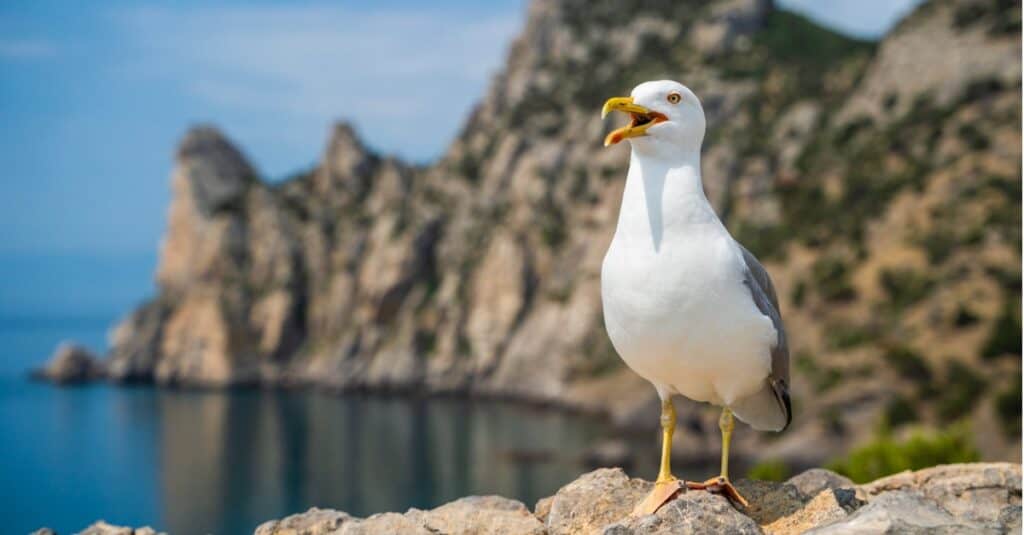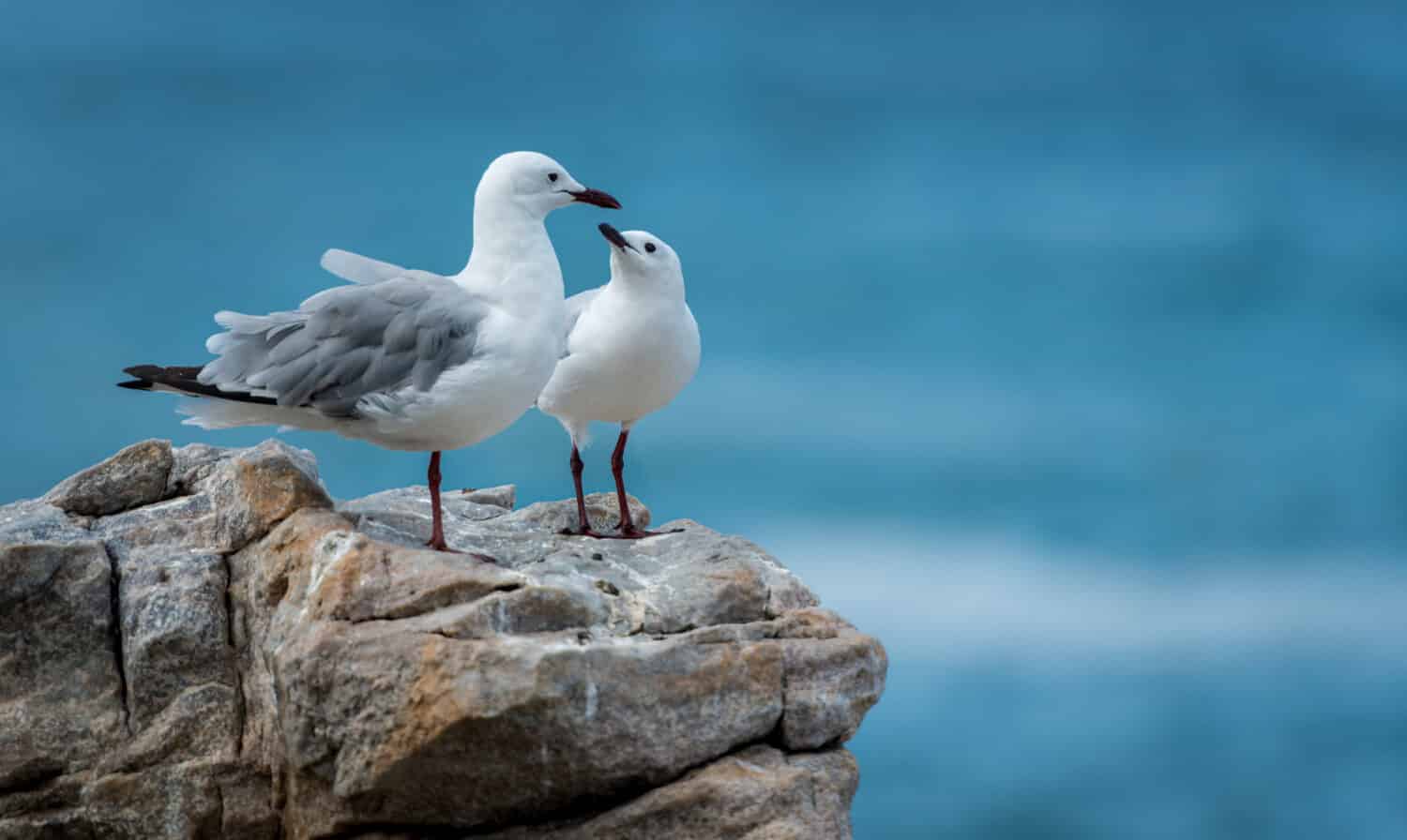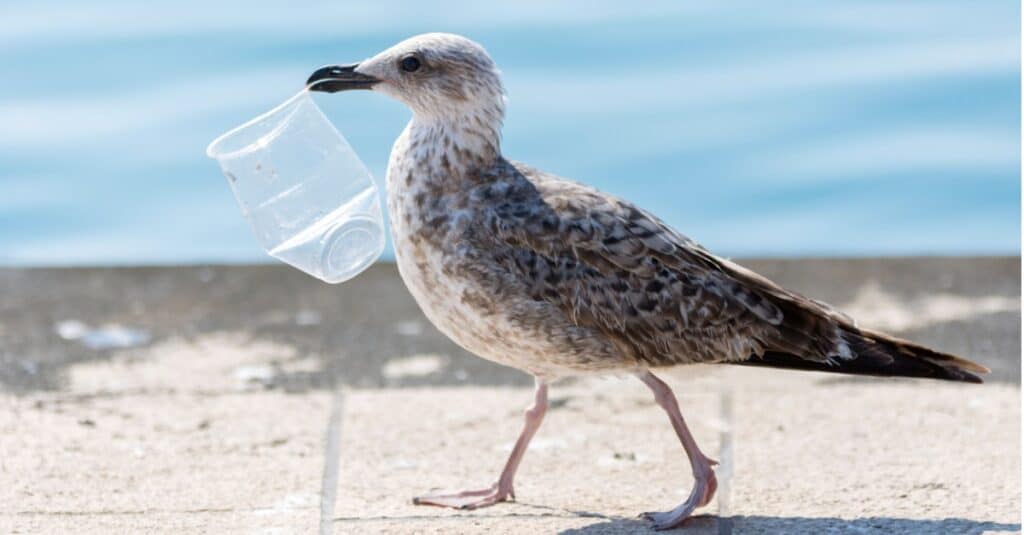Seagulls, one of the most well-known bird species in the United States, have unique nesting habits compared to what you would expect from the average bird. Also known as gulls, or by their scientific name Larinae, they are opportunistic nesters and feeders that can adapt to various environments and exhibit a remarkable ability to choose nesting sites that offer safety, accessibility, and resources for their young. And as they are most active throughout the day, their activity levels are closely linked to feeding opportunities and certain environmental factors. In this article, we will delve into the types of locations seagulls look for when making a nest, why seagulls nest on the ground rather than in trees, when you are most likely to encounter seagulls, the ecological impact of seagulls, and other relevant information about these fascinating birds.

Seagulls are most commonly found nesting in coastal areas.
©iStock.com/Evgenyi_Eg
Nesting Habits of Seagulls
Seagulls are highly social birds that often nest in large colonies called rookeries or breeding colonies, which can be densely populated. These colonies range in size from a few pairs to several thousand individuals, depending on the species and the availability of suitable nesting sites.
Nesting in colonies provides seagulls with several advantages. First, the presence of other individuals enhances their ability to detect and defend against predators. Seagulls will alarm call and defend their nesting territories vigorously, often engaging in territorial disputes and aggressive behaviors towards intruders that come too close to their nests, which provides collective protection for the entire colony. Additionally, nesting in large numbers increases the likelihood of successful breeding by improving mate selection, information sharing, and foraging efficiency.
They are also monogamous, forming long-term pair bonds with their mates. Once a pair has formed, they work together to select a suitable nesting location. Both males and females participate in the nest site selection process, with the female ultimately making the final decision. The male often brings materials to the female, who constructs the nest using her beak and feet.
Seagulls Nest on the Ground
Seagulls nest on the ground, constructing their nests using a combination of materials they find in their environment. They do not have specific height preferences for their nests as they are more concerned with finding open spaces near their foraging areas, which provide clear lines of sight to detect approaching predators.
The materials commonly used include grass, seaweed, sticks, feathers, and even man-made objects such as discarded fishing lines or bits of plastic. Their nests are typically shallow and loosely constructed, allowing easy access to eggs and chicks.
They have adapted various strategies to protect their nests and offspring, engaging in behaviors such as nest concealment, where they arrange materials around the nest to blend in with the surrounding environment. Seagulls may also engage in distraction displays, feigning injury or acting aggressively to draw attention away from the nest and chicks. These adaptive behaviors increase the chances of successful breeding and survival of their young.

Seagulls nest on the ground and have adapted various methods to protect their young.
©BMJ/Shutterstock.com
Preferred Nesting Locations for Seagulls
Seagulls show a preference for nesting locations with specific characteristics. They favor open areas that provide unobstructed views, allowing them to detect potential threats approaching their nests. Coastal areas and islands that offer elevated terrain can attract nesting seagulls due to the added advantage of improved visibility. Nesting sites that provide easy access to foraging areas, such as beaches, coastal waters, or open grasslands, are also highly desirable. Moreover, seagulls select nesting sites with suitable substrate materials for nest construction, such as sand, gravel, or bare ground.
Coastal locations are particularly appealing to seagulls for nesting. Coastal dunes, with their undisturbed sandy terrain, are also attractive nesting sites. These dunes offer seagulls a suitable environment with minimal vegetation and ample foraging opportunities along nearby shorelines. For nesting purposes, seagulls favor small and large islands. Rocky cliffsides and remote islands isolate seagulls from human disturbances and natural predators, ensuring a safer environment for their offspring. Moreover, islands provide a variety of marine food sources and often have an abundance of nesting sites, enabling seagulls to establish sizable colonies with a diverse range of nesting locations.
Seagulls Do Not Nest in Trees
Seagulls do not nest in trees like many other bird species. Instead, they prefer open areas with little vegetation. Trees may, however, play a role in the vicinity of their nesting sites by providing a perch or vantage point for the birds to observe their surroundings.
Seagulls have demonstrated adaptability by expanding their nesting locations to urban environments. It is now a common sight to see seagulls nesting on rooftops, chimneys, and other man-made structures. Urban areas offer seagulls a steady food supply, with access to discarded human litter and materials, making them viable nesting locations despite the absence of traditional coastal features.
Seagulls often exhibit strong site fidelity, meaning they return to the same nesting site year after year. Philopatry is the term to describe this behavior. Its influence is by the availability of suitable nesting habitats, familiarity with the area, and successful breeding experiences. Philopatry plays a crucial role in the stability and persistence of nesting colonies over time. While seagulls often breed and nest in coastal areas, some species in other locations undertake seasonal migrations to take advantage of different food sources and breeding opportunities. For example, certain species of seagulls found inland will migrate west and southwest during the winter. These migrations ensure access to abundant food resources throughout the year.

Seagulls return to their nests yearly.
©Joerg-Drescher/Shutterstock.com
Seagull Activity Patterns
Seagulls are diurnal birds, meaning they are primarily active during the day. Understanding their activity patterns and geographical distribution can provide valuable insights into their behavior and habitat preferences. They exhibit a range of behaviors depending on the time of day, environmental factors, and availability of food sources. As seagulls are opportunistic feeders, their activity levels are closely linked to their feeding opportunities.
Mornings
Seagulls are generally most active in the morning, particularly around sunrise. At this time, they engage in foraging flights, scanning the water’s surface and coastal areas for food. With considerable skill, they detect and seize prey such as fish, crustaceans, mollusks, insects, and even small mammals or birds.
Midday
During midday, seagulls tend to reduce their activity levels. They may rest, preen their feathers, or engage in social behaviors such as flocking or bathing in bodies of water. This period of reduced activity is due to the heat of the day and a temporary decline in food availability.
Afternoons and Evenings
Seagulls become more active again in the late afternoon and evening. As the day progresses, they resume their foraging activities, taking advantage of the tides and the movement of prey. Coastal areas and shorelines are bustling during these hours as seagulls scavenge for food items washed ashore or hunted in the shallow waters.
Breeding Season
These birds also exhibit increased activity levels and heightened territorial behavior during their breeding season; subsequently, seagulls lay eggs only once per year. This period, which varies depending on the species and geographical location, often occurs during the spring or summer months when food is abundant. During this time, breeding colonies are bustling with seagulls engaging in elaborate courtship displays, which include nest building, defending their territories, and aerial acrobatics, where calling and elaborate posturing attract a mate and reinforce pair bonds.

Seagulls are most active during the mornings and early evenings when food is most plentiful.
©iStock.com/krblokhin
Seagull Diversity Across the United States
The United States is home to a diverse range of seagull species, with regional variations in their distribution and abundance. Some states stand out as hotspots for seagull diversity due to their varied coastal habitats and abundant food resources. Six U.S. states host a significant number of seagull species, and they include:
Alaska
With its extensive coastline and rich marine ecosystems, Alaska boasts an impressive diversity of seagull species. Commonly found species along Alaska’s shores and coastal areas include the Glaucous-winged Gull, Herring Gull, and Black-legged Kittiwake.
California
California‘s vast coastline, from rocky cliffs to sandy beaches, offers a range of habitats attractive to seagulls. The state is home to species including the Western Gull, California Gull, and Heermann’s Gull.
Florida
The diverse coastal habitats of Florida provide nesting and foraging opportunities for several seagull species. You can observe The Laughing Gull, Ring-billed Gull, and Lesser Black-backed Gull along Florida’s beaches and estuaries.
Maine
Maine‘s rocky coastlines and offshore islands create ideal nesting sites and foraging grounds for seagulls. In this northeastern state, you can find species such as the Great Black-backed Gull, Iceland Gull, and Bonaparte’s Gull.
Texas
Texas, with its expansive Gulf Coast, offers a variety of habitats for seagulls. You can observe The Laughing Gull, Ring-billed Gull, and Herring Gull along the Texas coastline.
Washington State
With its diverse coastal ecosystems and proximity to the Pacific Ocean, Washington state attracts a range of seagull species, including The Western Gull, Glaucous-winged Gull, and California Gull.
It’s important to note that seagull distribution can vary within states depending on factors such as habitat availability, food resources, and seasonal migration patterns. Seagulls prefer nesting and foraging locations in coastal areas, including beaches, rocky shores, estuaries, and offshore islands.

Seagulls are commonly found on the west coast and east coast.
©zahorec/Shutterstock.com
Ecological Impact of Seagulls
Seagulls play an essential role in coastal ecosystems, contributing to nutrient cycling and controlling populations of small marine organisms. However, seagulls face conservation challenges like many other bird species due to human activities. It is essential to be aware of and mitigate these impacts to ensure the well-being of seagull populations. A few conservation considerations include:
Habitat Preservation
Protecting and preserving coastal habitats, including nesting sites and foraging areas, is crucial for seagull populations. Conservation efforts should focus on minimizing habitat loss, coastal development, and disturbance to nesting colonies.
Education and Awareness
Raising public awareness about seagulls and their ecological importance can foster a sense of stewardship. Educating coastal communities and visitors about responsible bird-watching practices, including maintaining a respectful distance from nesting colonies and refraining from haphazardly removing seagull nests, can help minimize disturbances during critical breeding periods.
Responsible Waste Management
Proper waste disposal is essential, particularly in coastal areas. Seagulls are opportunistic scavengers and are attracted to human-generated waste. We can minimize negative interactions between seagulls and humans by reducing litter and implementing effective waste management practices.
Pollution Management
Pollution can contaminate their food sources and environment, causing sickness or death. Instilling government regulatory measures for the use of pollutants and educating awareness on the consumer level of the risks of using known pollutants is an effective measure in controlling the environmental impact.
Monitoring and Research
Continued monitoring of seagull populations, their distribution, and nesting success rates is vital for understanding their conservation status. Research efforts can provide valuable insights into their behavior, breeding patterns, nesting habits, and the potential impacts of environmental changes on their populations.

Seagulls are attracted to human litter.
©iStock.com/Robert Pleško
Conclusion
Seagulls are captivating coastal birds that play an important role in our ecosystem and exhibit a remarkable ability to adapt to various nesting environments. While they do not nest in trees, seagulls select locations that offer safety, accessibility, and resources for their young. Coastal areas, islands, cliffs, and dunes are prime nesting sites due to their proximity to food sources and natural protection against predators. Seagulls construct their nests on the ground, using a combination of materials found in their surroundings, creating shallow and loosely built nests.
In addition to coastal habitats, seagulls have shown remarkable adaptability by nesting in urban environments; observed establishing nests on rooftops, chimneys, and other structures in cities. Urban areas provide seagulls with a reliable food supply, as they scavenge human litter and discarded food. Although nesting in urban locations may lack traditional coastal features, seagulls have successfully capitalized on the abundant resources available in these settings.
You are most likely to come across these birds when they are most active during the morning and late afternoon, engaging in foraging flights and scavenging for food along the coastlines. Found in almost every state, the United States hosts a variety of seagull species, with states such as Alaska, California, Florida, Maine, Texas, and Washington offering rich coastal habitats and a high diversity of seagull species, making them some of the most common and well-known birds to the people who reside here.
The photo featured at the top of this post is © xpixel/Shutterstock.com
Thank you for reading! Have some feedback for us? Contact the AZ Animals editorial team.






